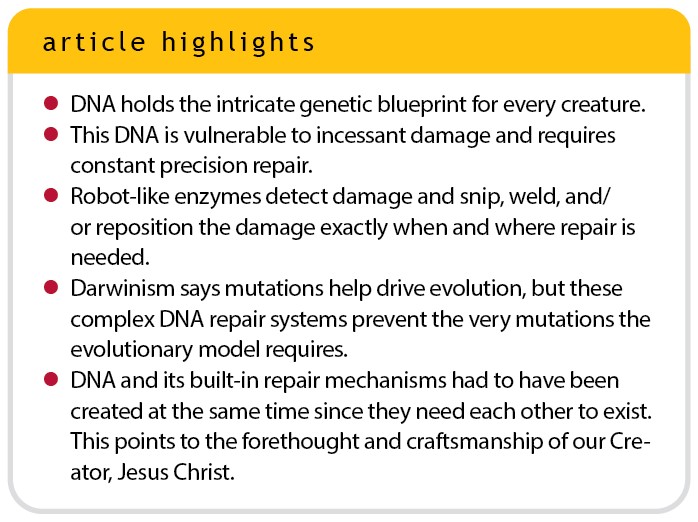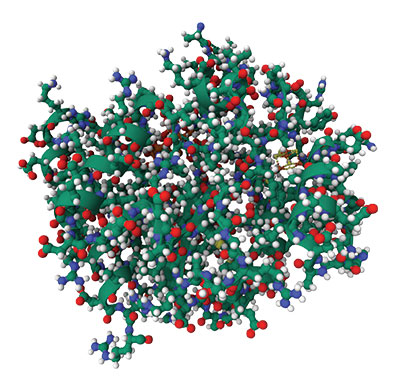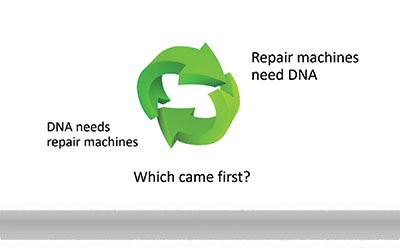 DNA contains the instructions needed to build a whole body from one fertilized egg cell. Chromosomes consist of double-stranded DNA that uses specifically paired nucleotides in precise sequences to encode this information. Our Creator selected four nucleotides for this, with each pair comprising a “rung” in the long, ladder-like biomolecule.
DNA contains the instructions needed to build a whole body from one fertilized egg cell. Chromosomes consist of double-stranded DNA that uses specifically paired nucleotides in precise sequences to encode this information. Our Creator selected four nucleotides for this, with each pair comprising a “rung” in the long, ladder-like biomolecule.
In today’s sin-wrecked world, factors like certain chemicals, rogue electrons, radiation, and rare copying errors constantly assail DNA.1 The DNA in each cell suffers tens of thousands of damages each day.2 Without intervention, it wouldn’t take long for a lethal number of errors to accumulate. How does our DNA survive such overwhelming damage?
God expertly outfitted all living cells in the beginning with the required tools to keep DNA’s coded information pristine. Life depends on DNA repair pathways. Every cell in organisms from germs to geraniums constantly uses them. Molecular and cell biologists have used clever techniques to peer into the inner workings of cells, revealing multiple ingenious tactics that repair DNA.
DNA repair pathways use dozens of enzymes. Each enzyme performs a specific biochemical reaction over and over like a molecular robot. Uracil-DNA glycosylase, shown below, is one such enzyme. It helps remove and replace uracil, a nucleotide that belongs in RNA but can mistakenly enter DNA.3

Some DNA repair strategies use enzymes called helicases to unwind DNA to allow yet more enzymes access to problem areas. Another enzyme snips out not just one nucleotide but whole offending sections. It then signals proteins to bring the correctly matching DNA base into position. Like precision robot welders, these enzymes help the newly positioned nucleotides bond at just the right atomic positions.
DNA repair systems also need detectors to surveil the integrity of chromosomes. Some detector proteins clamp on to DNA’s double helix. They slide along a length of DNA to make sure all the nucleotides still fit right, like a hand feeling the inside of a bicycle tire for thorns. A nucleotide mismatch is one type of DNA damage that forms a bulge. When the detector finds it, it stops and sends a signal to recruit the right tools to repair the section.
Other sensors send electrons around a loop of DNA in a process called charge transport (CT) that detects base-pair mismatches or other anomalies.4 CT uses various proteins to signal “one another to search cooperatively for damage in the genome.”5 This suite of connectable enzymes came preprogrammed to interpret the failed return of a delivered electron as an indication of DNA damage within each section of DNA it tests. The speed of an electron travelling along DNA makes this a remarkably efficient method of detecting lesions, or harmful structural changes.
Speaking of electrons, a completely different repair strategy reflects yet more of the Creator’s wisdom. When chemicals called free radicals rob an electron from one part of DNA, other electrons slide into that now-vacant slot. Electrons that keep sliding along the DNA strand to fill a moving void would soon cause an unwanted chemical reaction if not for an ingenious, baked-in solution. Jesus placed sequences of guanine-cytosine pairs just outside important protein-coding regions. These outside guanines absorb the chemical harm while the coding regions stay perfectly intact.6 These guanines are in just the right places to absorb the loss of electrons from nearby nucleotides.
Diligent research has revealed even more clever solutions to specific DNA troubles. The nucleotide excision repair (NER) pathway is the simplest of the 12 DNA repair pathways studied thus far. NER uses 30 proteins, including five enzymes, to snip out and replace sections that have, for example, abnormally bonded thymine bases called thymine-thymine dimers.7 UV radiation causes neighboring thymine nucleotides to bind directly to one another. Dimers interfere with DNA replication (when cells divide) and DNA transcription (when DNA templates are copied to messenger RNAs). The cell would cease to function without NER.
A unique enzyme called photolyase can also repair thymine-thymine dimers. It clamps onto the dimer and collects a photon of blue light. Then it transfers that light energy to the offensive dimer to break it back into two separate thymines.8 Clearly, the Lord Jesus considered and took care of all life’s details from the very beginning.
Neo-Darwinism holds that mutations help drive evolution, but over 1,000 researchers publicly disagreed with this model when they signed “A Scientific Dissent from Darwinism.”9 One reason why experts aren’t persuaded by neo-Darwinism is that DNA repair systems prevent the very mutations the evolutionary model requires. Some have called this the mutation protection paradox.10

DNA repair also presents a chicken and egg problem. Which came first—the DNA that stores the blueprints for dozens of required DNA repair proteins or the DNA repair proteins that are required to maintain DNA? Clearly, they must have been created at the same time. They arose when “He spoke, and it was done; He commanded, and it stood fast” (Psalm 33:9).
These Darwinian problems disappear if the Lord indeed created “the earth, the sea, and all that is in them” (Exodus 20:11). Natural causes cannot overcome the mutation protection paradox, the DNA-DNA repair dilemma, or the clever craftsmanship and foresight seen in DNA repair enzymes. Therefore, we ought to look to a supernatural cause. “All things were made through Him” who exists apart from creation (John 1:3). DNA repair systems point to a Creator with the same wisdom and lovingkindness that belong to the Lord Jesus Christ.
References
- DNA replication machinery is so effective and precise that it leaves behind only one error in about one billion nucleotides.
- Researchers estimate that a typical human cell manages 2,000–10,000 depurinations, 600 depyrimidinations, 10,000 oxidations, 55,000 single-strand breaks, and 10 double-strand breaks each day. Tan, C. L. and R. Stadler. 2020. The Stairway to Life: An Origin-of-Life Reality Check. Evorevo Books, 136.
- Slupphaug, G. et al. 1996. A nucleotide-flipping mechanism from the structure of human uracil– DNA glycosylase bound to DNA. Nature. 384 (6604): 87–92.
- Boal, A. K. and J. K. Barton. 2005. Electrochemical Detection of Lesions in DNA. Bioconjugate Chemistry. 16 (2): 312–321.
- Boal, A. K. et al. 2009. Redox signaling between DNA repair proteins for efficient lesion detection. Proceedings of the National Academy of Sciences. 106 (36): 15237–15242.
- Dohno, C., E. D. A. Stemp, and J. K. Barton. 2003. Fast Back Electron Transfer Prevents Guanine Damage by Photoexcited Thionine Bound to DNA. Journal of the American Chemical Society. 125 (32): 9586–9587.
- Spivak, G. 2015. Nucleotide excision repair in humans. DNA Repair. 36: 13–18.
- Zhang, M., L. Wang, and D. Zhang. 2017. Photolyase: Dynamics and electron-transfer mechanisms of DNA repair. Archives of Biochemistry and Biophysics. 632: 158–174.
- A Scientific Dissent from Darwinism. Posted on dissentfromdarwin.org.
- DeJong, W. and H. Degens. 2011. The Evolutionary Dynamics of Digital and Nucleotide Codes: A Mutation Protection Perspective. The Open Evolution Journal. 5: 1–4.
* Dr. Thomas is Research Scientist at the Institute for Creation Research and earned his Ph.D. in paleobiochemistry from the University of Liverpool.













